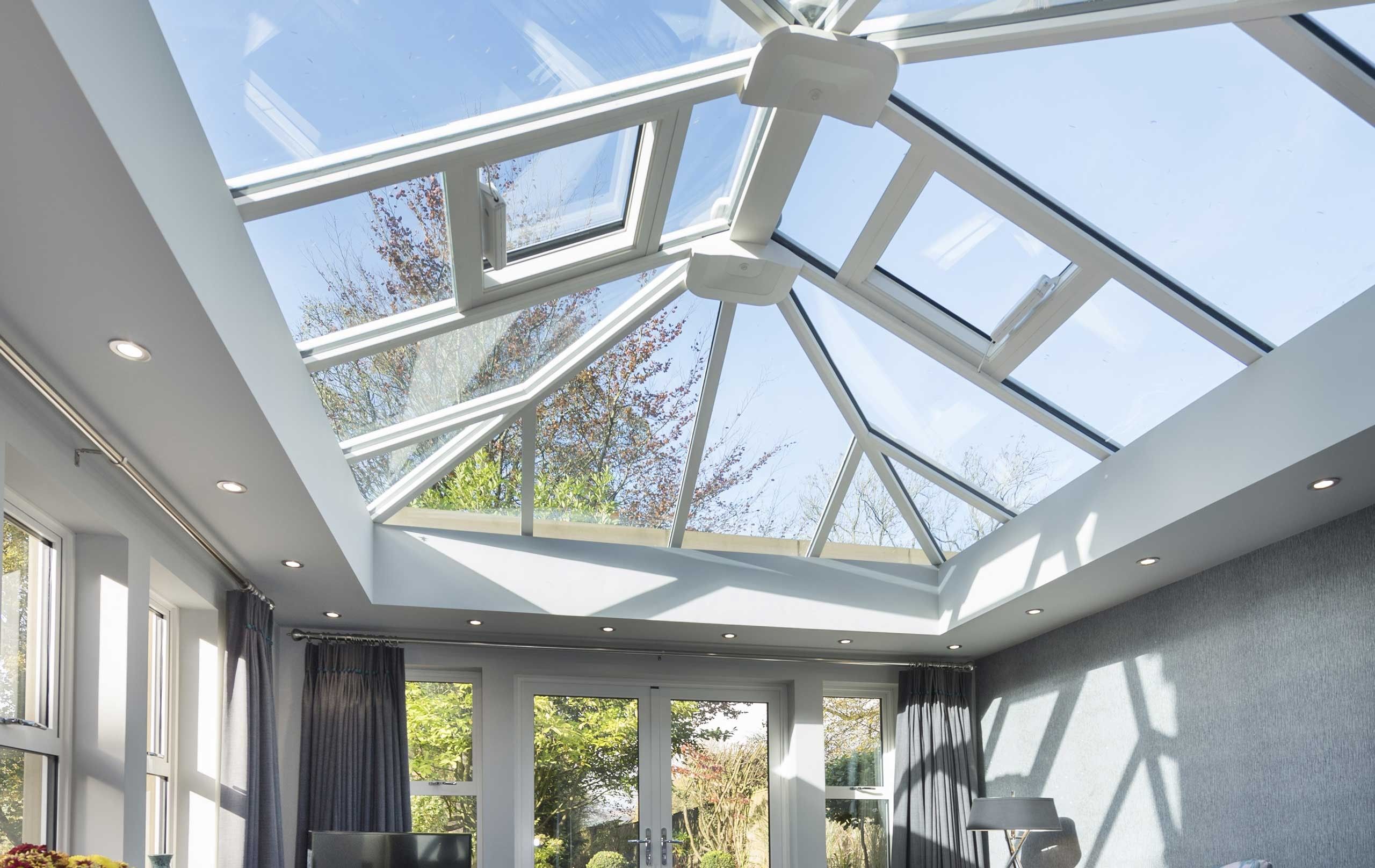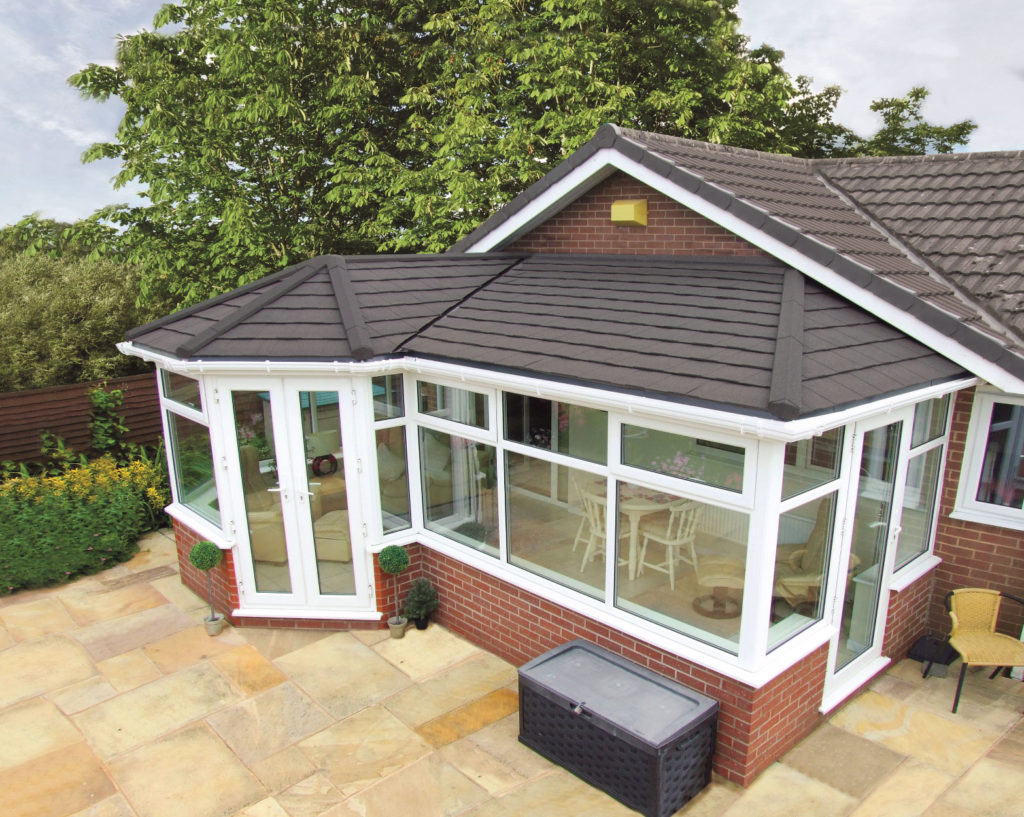How much does a lightweight conservatory roof cost?
Homeowners with conservatories fitted with single glazed or polycarbonate roofing panels are seeking refurbishment options and solid roofs are very much in vogue. A good average cost of a lightweight conservatory roof replacement is between £5,000 and £12,000 for a lean-to conservatory roof replacement. The cost will depend on the size of the tile you choose; although larger tiles are usually more expensive, you need less of them per square metre.
Last Updated: October 2022
Want a more accurate tiled conservatory roof cost? Tell us about your project and we can advise you on the potential costs. Want a quick quote from local installers? Fill out the form below. Time to complete: 30 seconds!
Many of the conservatories which were installed between ten and twenty years ago during the so-called ‘golden age’ of peak popularity for this particular home improvement are now looking rather tired and outdated.
The challenge with a solid clay tile or slate roof is not just the cost of upgrading but also the weight of the new roof. Opting for a traditional solid roof may require substantial structural works to the frame of the original conservatory, just adding to the cost. Lightweight roof tiles avoid this issue and provide the on-trend look without the cost of heavy standard tiles and any associated work to support them.
What is a lightweight tile roof and why have they become so popular?
As many householders with a standard glazed roof on their conservatory can bear testament to, there can be many drawbacks to this traditional style of roofing including:-
- Glazed roofs are difficult to keep clean and clear of debris particularly if there are trees nearby
- They are noisy when it rains and soundproofing can be an issue with external environmental factors like traffic hum, aircraft and disturbance from neighbours or nearby businesses
- The conservatory can become too hot in the summer requiring the installation of roof blinds to manage temperature and glare which is both tricky and expensive. Internal furnishings and fabrics will fad or even become bleached by the sunlight
- A glass or translucent roof is a poor insulator and thermal regulator which means the conservatory can be too cold in the winter months. Condensation can build-up and this can affect your energy efficiency rating as well as your heating bills
As many glass roofs installed in the peak time of conservatory popularity are reaching the end of the natural lives, wear and tear is beginning to appear and they are becoming less weatherproof. A lightweight tile roof provides the perfect replacement for a tired, glazed conservatory roof.
Solid roofs are becoming very popular as both a refit option on existing conservatories and a feature on new build conservatories but many existing builds cannot bear the weight of a traditional tiled roof. A lightweight tile roof has all the advantages of traditional tiling without the usual weight associated with a traditional tile. New modern lightweight materials means you can have the look of a solid roof without necessarily having to upgrade the original structure. Lightweight roof tiles are made from a mix of both virgin and recycled polypropylene.
What are the cost factors when replacing your current roof with a lightweight tiled roof?
A builder’s estimate will be split between labour and materials. There will also be a charge to dispose of the waste products from the old roof plus any scaffolding hire.
Other cost factors
Some lightweight roof tiles are not as lightweight as others; it depends on which style and brand you choose. It may be the case that the roof battening requires some degree of upgrade once the original roof has been stripped away but not nearly to the extent that would be required for traditional concrete roof tiles. The surrounding structure of the conservatory is also relevant to this but a proper survey at the outset should pick this up before work starts and anticipate for these costs in the estimate.
You should not require planning permission to change your old glazed conservatory roof to a new lightweight tile roof as the law changed in 2010. Prior to that date, a conservatory roof was defined as 75% translucent and so in order to remain within that classification, roofs had to be mostly entirely glazed or fitted with polycarbonate. However, if your home is listed or within a conservation area, then you will need to apply for planning permission to replace the roof and there will be a cost associated with this.
You may wish to renew or upgrade your rainwater goods to suit your new roof and if you opt for a flat ceiling inside the building, then you should factor in the costs associated with fitting this and redecorating.
Use our roof cost calculator to learn more about how much your roofing project could cost and how much you may need to budget.
Get a lightweight roof quote
See how we work below.

1. Tell us some details of exising roof
Tell us the details of your existing conservatory roof and the lightweight roof ou would like.
2. Tell us your UK address
We have a national network of roofers around the United Kingdom. Whether you are in Scotland or London, we can help.
3. Recieve a no obligation quote
You'll receive up to 4 no-obligation quotes and have a better idea of the roof replacement cost.
What are the advantages of a lightweight tiled roof?
Lightweight tiled roofs remove all of the drawbacks and disadvantages associated with a traditional glazed or polycarbonate roof and the expense and upgrading work required with traditional tiles, breathing new life into your conservatory.
Here are some of the advantages:
- Lightweight tiles are easy to cut and fit, they generally weigh only around 6-10kg per square metre compared to traditional roof tiles and slates which can be anything up to 75kg per square metre
- A solid roof offers all the advantages of proper temperature control and thermal regulation and insulation meaning your conservatory will no longer be too hot in the summer and too cold in the winter. And you will feel the benefit on your heating bills
- Tiles increase privacy which means you can retain all the advantages a conservatory has to offer but enjoy more seclusion particularly if your building is overlooked by neighbouring houses
- A lightweight tile roof will offer a perfect seal and is completely weatherproof – no more leaking glass panels
- Lightweight roof tiles transform a building giving it an air of permanency and connection to the main property – it will look more like an extension rather than a ‘bolt-on’ but still retains all of the original advantages that made you choose a conservatory in the first place. So, a real ‘room-like’ feel just with lots of natural light
What is the process of replacing the current conservatory roof with a lightweight tiled roof?
Once you have sourced your builder and established whether or not you require planning permission, works can proceed. The old roof is carefully removed and any repair works or upgrading undertaken to the existing roof structure. This is also an opportunity to renew and refurbish any of the glass wall panels. The lightweight tiles are fitted to the roof structure and then rainwater goods added to complete the job. The process is usually much quicker than fitting a traditional tiled roof because lightweight roof tiles are quick and easy to work with and the project won’t be delayed by any significant requirement to upgrade the original structure to bear extra weight.
Get quotes from reputable suppliers here
Save 1,000's on your lightweight conservatory roof project. Get no-obligation quotes today.
Frequently Asked Questions
What is the lifespan of a lightweight roof tile?
Most lightweight roof tiles which are made of modern materials as opposed to a traditional clay tile are guaranteed for 25 years. They also have the advantage of being fully recyclable when you do need to replace them.
What are the green credentials of lightweight tiles?
Lightweight tiles are made from recycled plastic and are fully recyclable when they reach the end of their natural life so completely eco-friendly.
What choices of tile are available?
There are a variety of roof tile colours to either match or contrast with your existing home. Most products offer black or a natural stone granulate in Forest Green, Granite Grey, Traditional Red and Broadleaf Brown so it is easy to find a look that suits your conservatory. The finish is colourfast and so will not fade, retaining a ‘just fitted’ look throughout the lifespan of the roof.
If the tiles are lightweight, are they robust and weatherproof?
Lightweight roof tiles punch well above their weight. They are UV resistant and non-corrosive and offer excellent thermal insulation and soundproofing as well as being completely weatherproof throughout their lifespan.
Are there any disadvantages?
Hardly any other than that they do have a natural life of around 25 years whereas a traditional tiled roof would endure for decades. But compared to the far shorter lifespan and additional drawbacks of a glazed or polycarbonate roof, lightweight roof tiles still represent excellent value for money and create a very good aesthetic finish.
Will fitting lightweight tiles increase the value of my property?
Any substantial upgrades to the fabric of your home will increase its value. The upgrade of thermal and temperature regulation within the conservatory will also improve your energy rating as well which is very important when you come to sell.
Can you lay tiles on top of your existing conservatory roof?
Not usually, it is recommended that the old roof is removed and the new tiles fitted to the battens otherwise the quality of finish and the weatherproofing will be seriously compromised. You are also likely to invalidate any manufacturer's warranty.
Do I need planning permission?
The only trigger points for planning permission would be changes to the roof of a conservatory attached to a building that is either listed or within a conservation area or both. Since 2010, the definition of a conservatory has been broadened and the requirement to have a roof that is 75% translucent has been relaxed. If you are uncertain then you can discuss this with your local planning authority before you start work.
Can I install roof lights or skylights into a conservatory roof?
If you want to retain some view of the sky in your new conservatory then your lightweight tiled roof can be fitted with roof lights or skylights.
Can I fit a tiles myself?
A competent DIY enthusiast may find they are able to do this work for themselves but if you require any structural upgrading to the battens or mainframe of the conservatory or want to install roof lights or Velux windows then this is better left to a professional builder. You will also benefit from a manufacturer’s guarantee both for the lightweight roof tiles themselves and the overall project which is provided by the builder.
How can I finance my new roof?
Some roofing companies and builders offer finance packages to help you spread new roof or roof repair costs. They team up with a financial institution to offer different funding opportunities depending on your personal circumstances in the same way that you would finance the purchase of a new or used car. There will be different choices available to you depending on how much deposit you have available and your credit score. Some options require a high deposit, as much as 50%, but can then offer you zero interest payments for two years following during which the balance of the cost is repaid. Other, lower deposit options will run for longer with usually higher monthly payments and an applicable interest charge.
The other option is to speak to your mortgage company about a further advance or Home Improvement Loan. This is usually for larger sums of money and the conservatory roof might be one of a range of home improvements and upgrades you are looking to make. This will be subject to the amount of equity in your home as this sum will be extending your mortgage and also the requirement that you pass your lender’s affordability criteria. The debt will usually run for the remaining term left on your mortgage. For older people who have paid their mortgage off, there may be Equity Release schemes available to fund this and other home improvements.
The cost of replacing a glazed or polycarbonate roof on a conservatory with a lightweight tiled roof is a fairly modest sum in the scheme of home improvements and the best route of finance is usually via your contractor, quicker and easier than going back to your main lender.
For more information on conservatory projects and planning permissions, see guidance from the government and Planning Portal.



